Theodore Richard Brownell
1905 - 1990
Theodore Richard Brownell was born Sept 6, 1905 in Missouri to
Oscar William & Ella Gertrude McGinty Brownell. March 26, 1928
Theodore married Cathrine Bell Murrey In Pulaski Co., Ar. The bride and
groom both resided in Fort Smith, Sebastian Co., Ar.
Theodore was a Chief Yeoman with the US Navy serving on the USS Canopus.
The area he served in was the Southwest Pacific Theatre: Philippine Islands.
Following is from Alma Salm's Memoir
https://wartimememoriesproject.com/ww2/view.php?uid=214821
USS Canopus was a WW2 submarine tender and carried food, fuel, torpedo’s, supplies, maintenance
equipment, and even relief crews for various US submarines.
From her the subs obtained their provisions, lubricating and fuel oils,
and equipment and the performance of necessary repair work with which to keep that
deadly undersea engine of war in the highest of material efficiency.
Fleeing the Japanese attack on Manila
The Canopus, camouflaged with paint and large fish nets [so that Japanese planes wouldn’t bomb it],
was moored alongside the dock between piers three and five in Manila prior to Christmas Day 1941.
From that point, we who were attached to her, could see the burning of the U.S. Naval Station
at Cavite, nine miles away across the southwest corner of Manila Bay.
On April 9, 1942, the day that the US surrendered Bataan to the Japanese, her crew moved
the USS Canopus in to deep water of Mariveles Harbor and scuttled her, so she
could not be captured or salvaged by Japanese forces. The Canopus crew then fled to Corregidor
island, allowing them to escape the Bataan Death march by mere hours.
Escaping the Bataan Death March by mere hours
Word came from Corregidor at the eleventh hour [probably late on April 8 or early on
April 9, 1942] that our Naval unit would be permitted on the “Rock.”
Editor’s Note: This means that the crew of the Canopus would be allowed on to US military
base on Corregidor island instead of having to surrender to and become POWs of the Japanese.
This decision spared Salm and the other Canopus crew the horrors of the Bataan Death March.
However, the majority of the Canopus crew became POWs a month later.
We worked furiously most of the night to load the lighter boats with miscellaneous stores and
small equipment to take with us after learning that the fall of Bataan was imminent and our
forces perhaps would not be able to hold out until morning.
Staying ahead of the Japanese advance
Our motor launch was the last to leave the ship [before it was scuttled].
We headed toward the small angle dock a thousand yards up the east side of the harbor to
pick up the last of the navy demolition squads who had been busy meantime in blowing up our
storage tunnels on shore.
The scene reminded me of a gigantic Fourth of July celebration back home.
Our troops beyond the ridges were destroying all ammunition and supplies in the wake of the
fast moving Jap advance. The result was not only the almost continuous thunderous detonations
but a huge conflagration which illuminated the surrounding country.
This, together with gigantic explosions from the heavy dynamite charges in the string of tunnels,
filled the air with heavy acrid fumes and smoke which lay like a pall over the placid waters of
the bay.
The little light from a waning moon gave it all a very eerie appearance.
A traumatic goodbye
Suddenly the whole hillside in front of us erupted in a tremendous explosion that was so great
it almost tore us loose from the boats.
US WW2 sailor and casualty Lynn C. Weeman died during Battle of Bataan
Warrant Machinist Lynn C. Weeman was one day away from turning 29 when he was killed in
action while fleeing the Bataan Peninsula.
A great number of drums of gasoline had been stored in a tunnel ashore. When the entrance was
dynamited and sealed, apparently the fire set off the gasoline. This caused a gigantic
explosive charge to form.
The upheaval took place directly in front of us about two hundred yards away. In addition to
the mighty concussion, it hurled huge boulders directly into the harbor. The calm waters in the
immediate vicinity were whipped into turbulence from the fury of it all.
I had been in brief conversation with Warrant Machinist [Lynn C.] Weeman when the fireworks from
the hillside broke loose. This unexpected detonation hurtled massive chunks of rock down through
the canopy of the little launch.
I was sitting only three feet from Weeman, but he never spoke again. His head had been practically
severed by the falling stone missiles, while I only felt a few small pebbles no larger than peas
rain gently on me.
It was with mingled feelings I took this last look towards distant Mariveles Harbor and the
last resting place of the Canopus — about eighty feet down in “Davy Jones locker.” I hoped
that Japs would not succeed in salvaging her as they had been able to do not infrequently
with other sunken vessels.
THE ARMY 92ND GARAGE: THE FOUL, POLLUTED, SWELTERING POW CAMP ON CORREGIDOR
While it eventually happened that we were taken away from Corregidor, it did not prove to be done in the manner we expected.
The first Corregidor POW march
The next morning, May 8, 1942 [two days after the US surrendered Corregidor], the Japs began shouting and screaming at everyone in
the entire area to immediately form into marching columns on the road. Those who had anticipated this move had already prepared
small packs or barracks bags with a few clothes and other essentials, and carried them along.
In a few moments, we were marching up the sloping road along the south side of Malinta Hill, eastward into the broiling sun, for a
distance of about one mile.
It was an arduous journey for many who were half well and ailing principally from malaria, even at this early period. As the leading
battalions disappeared from sight over the brow of an eastern ridge, it reminded one of lost souls vanishing into oblivion.
Descending down the steep hills nearing the end of our journey, we passed numbers of black and bloated bodies of our unburied dead lying
on the dry dusty roads. They had fallen during the battle of Monkey Point two days before, and the Japs had not as yet permitted burial.
Decomposition, which is rapid in the tropics, was already setting in. This had brought swarms of big blue flies which amassed over them,
concentrating on their faces which were exposed.
“A hot oven” — the Army 92nd Garage
Our destination was a small, almost sea-level, area about six hundred feet square and flanked on the eastern side by two or three
large and old galvanized iron buildings painted black.
They had been perforated with hundreds of holes due to previous enemy bombings and strafing runs. There were a few bomb craters on
the perimeter of this open space.
This place was known as the Army 92nd Garage.
Steep hills rose up almost abruptly from three sides. The fourth side opened to the sea bay on the south which was strewn with large
rocks and boulders.
For the next seventeen days this tiny packed square was to be the home of approximately nine thousand American uniformed fighting
forces that included a few hundred civilians and about two thousand uniformed Filipino soldiers and civilians.
This area held the heat of a hot oven. It was the hottest and driest time of the year, just before the rainy season.
Inadequate, makeshift shelter
The galvanized buildings were heavily covered with dirt and filth. After setting up a First Aid Station and various work detail centers,
little room was left for general occupancy in the north section; and the south was entirely occupied by the Filipinos who were segregated
into that division and the adjacent areas.
Most of us settled down on the ground outside. There were no facilities whatsoever here.
We were protected from the sun by small sections of canvas shelter halves, blankets, or any other covering we had the forethought
to carry with us. These we rigged up on some small sticks we had gathered from the sparse growing brush nearby and what we could
salvage from the general trash lying about.
Under these small inadequate shelters, we crowded together in an attempt to share what little protection they provided. Needless to
say, having no pads or mattresses, we slept on the ground. Officers and enlisted men were branded with a number painted on the back
of their shirts.
The first work detail — burying the dead
One of the first work details assembled was sent out to bury those dead comrades who we had passed on our march to camp.
Due to the decomposed condition of the bodies, wire was attached to a leg and the corpses dragged a short distance to a shallow grave
for burial. One of the Army chaplains was present and conducted funeral services as the burials took place.
We also buried all Jap dead whom they did not burn. Returning from a food foraging expedition, I was among those who witnessed the burning
of the bodies of six Jap officers. A large funeral pyre was built and upon it were placed these corpses. I understood ashes were to be
sent back to Japan to be placed in their respective shrines, a very common practice accorded to their soldier dead.
Foul water and parched throats
Very little drinking water was available at this point; what there was occupied a shallow well. After only a couple of dozen bucketfuls
were drawn, the well became nearly dry. We would patiently wait a half-hour or so until water seeped in sufficiently to begin operations
again. It was very brackish and not pure enough to drink without treatment of iodine.
After several days a small one-inch water pipe was laid to our present internment area. There was little pressure at best. It flowed very
slowly most of the time and at certain periods was shut off completely, long before the wants of many of us had been satisfied.
Although it was tepid and ordinarily foul tasting, under the circumstances it tasted good to parched throats, although one treated it
against infection if they had the necessary chemical. Some drunk without the precaution on a chance nothing serious in the way of
intestinal parasites would result.
The never-ending water line
There was always a water line. Here every type of container, old or new, that could be salvaged from the rubble about us was pressed
into use. Gasoline tins, meat cans, gasoline drums, metal cylindrical powder cases, military water containers and canteens, washing
buckets: all saw duty to obtain this precious liquid.
We would stand in the water line sometimes as long as three hours in the fierce heat before our turn arrived. Those few individuals
constituting the small group to which I was attached (a sort of family unit) would each take turns—”sweating” out the water line in
relays after an hour of standing in the torrid heat. This line was continuous all day and night.
The water was only available in quantities for drinking and cooking purposes. None was available in which to wash clothes or to bathe.
We attempted to wash clothes in salty sea water and with the aid of a good sunning it helped, although it was far from a satisfactory job.
Foraging for food
No food was furnished to us by the Japs at this time.
A little later on some uncooked food was brought into the camp by our own working parties for general rationing from a central point;
but it was wholly inadequate and not systematically distributed for the most part, at any time.
Reluctantly the Japs finally gave us permission to forage for food and water among our surrendered installations a mile away on Malinta Hill.
Map of Corregidor island, The Philippines, showing locations of Malinta Hill, the 92nd Garage Area, Bottomside, and South Harbor during WW2
Image 7. The 92nd Garage Area was about a mile away from Malinta Hill, where the majority of the POWs when captured. They marched to the
92nd Garage area two days after capture and remained there for 17 days without adequate food or water. They were eventually allowed to
forage for food in tunnels of Malinta Hill. On May 23, 1942, they retraced their steps past Malinta Hill and to the pier at South Harbor,
where they were loaded on to Japanese transport ships.
This food was now war booty of the Japanese, and what little we did salvage this way was by sufferance only. They were not very disposed to
let us pass the posted guards, in order to salvage clothes and other badly needed items strewn about the tunnels in and around the abandoned
fox holes, pill boxes, and dug in positions.
Groups of one hundred men under the leadership of a field officer not below the grade of Lieutenant Colonel
(identified by a white arm band covered with Japanese characters) were permitted to travel for water and to the upper regions for
necessities. We were warned that the groups must return intact.
Upon arriving back at the camp, if an American was slow in returning due to being burdened with food or water supplies, at times
was beaten with a rifle butt.
The ravaging diseases begin
And already the diseases dysentery, diarrhea, and malaria began ravaging many of our number, although this was mild in comparison
to what lay ahead. We had to take care of each other as best we could.
Our medical officers had a little medicine and distributed it the best they knew how; but they were totally without many essential drugs.
The sick and weak and those who frequently fainted from heat prostration in this oven of a place lay around the small First Aid Station.
“Inhumanly turned out of the hospital”
The beds were stacked 3 high. There were 1,000 beds in this hospital.
Occasionally one or two were permitted to be littered back up the hills for temporary treatment at the hospital in the
[Malinta Hill] tunnels where there were yet many of our worst cases. However, a lot were discharged prematurely and
sent down to us in order to make room for Jap sick and wounded who were also being attended by our doctors.
Many of these afflicted Americans were far from well but, nevertheless, had been inhumanly turned out of the hospital. It was
pitiful indeed to see some of those men who were so sick, many with high fevers, just laying there in the dirt without proper food,
medicine, and proper attention in that unbearable heat.
A certain confusion and chaos reigned everywhere. An attempt to bring about a semblance of order was only partially effective.
Flies, of course, were everywhere. The large red-headed blue bottle species, much larger than the ordinary blowfly here in the
United States, as well as the small type house fly, multiplied by the thousands because of the ideal breeding places in the open
straddle trench latrines. Although a certain amount of fire and disinfection was possible to eliminate them, it was too meager,
and swarms of flies carrying death-dealing infections continued to breed by the thousands.
Hot, cloudless, stagnant days
The men took advantage to keep cool form the broiling tropical sun by remaining nude in the bay water at depths up to their necks.
We were continually dripping perspiration as the sun overhead hung in a cloudless sky like a fiery ball during those days. Not a breath
of air stirred during most of the day, and, at times, we were almost suffocating.
How we watched and waited; and how slowly the sun moved across the heavens. And when, at about six p.m., it slipped below Malinta Hill
to the west, we only then had surcease from its flaming rays. By midnight it became a little cooler so one could snatch a few hours of
sleep without perspiring before the process was begun all over again.
Due to poor sanitation and a lack of interest in personal hygiene, the ocean water and beaches in our immediate vicinity became polluted.
Some of the filthy individuals defecated into the sea while bathing, which contributed to further infections among us.
Many men were afflicted with impetigo, or locally referred to as “Guam Blisters”; and, being very contagious, the conditions were
ideal for its spread until hundreds were infected in a very short time. In these cases the sores and ulcers grew in size with a
yellow pus-like scab formed or open lesions resulted. It was sickening to see; and very painful to endure.
The rains come and the POWs leave
In the early hours of the morning of May 23, 1942, the first torrential rain storm of the season fell. Daylight found us huddled together,
completely drenched as only a tropical deluge can saturate one.
Dog tired from the lack of rest the previous night, nevertheless we were enthused a little to learn that orders had been received to
evacuate this concentration area.
We retraced our steps to “Bottomside”.
As we marched along—a grim, dejected lot—we passed within the shadow of the church. As a result of the constant bombing,
practically all the surrounding buildings were reduced to rubble. However, the little stone chapel appeared largely
undisturbed and stood tranquil amid the chaos and ruin. Through the partly demolished walls one glimpsed the large heavy-paged
bible upon the pulpit, a comforting influence.
On May 23, 1942, the POWs left the 92nd Garage Area. They marched along the South Shore Road for a mile past Malinta Hill
into the Bottomside area. They then waited on the small pier extending into South Harbor to be transported to 3 Japanese ships
in South Harbor.
After being herded together again for several hours under the ever-present blazing sun, we were marched in groups down to
the small pier extending into South Harbor.
In various small boats and launches we arrived alongside three old and extremely filthy Japanese troop ships.
While on board we endured the usual pastime — repeated searching of our persons by the Jap crews.
Although my watch had been taken from me on round one, they never did find my meager supply of Filipino currency hidden up
under my cap insignia, guarded by the American eagle.
Onboard a Japanese hell ship: The Corregidor POWs
The night and day they spent on the ships would have been cramped and unpleasant. From Chicago
Daily News. The ship’s hold, into which we were jammed, was equipped with bunk tiers covered
by vermin-infested straw matting upon which, undoubtedly many times previously, had lain
dirty Jap troops and coolies.
We lay shoulder to shoulder.
The air was hot, sick, and foul. There was no ventilation except from the small booby hatch
thru which we gained entrance.
Literally every foot of space was utilized, and many were compelled to spread over the top
hatches like a “starfish spread out over a clam,” to use an “old salt’s” expression. Others
crammed into the small weather deck spaces. Decks were bare, rusty metal.
That night it rained again, and we who were obliged to lie on the bare iron deck were
anything but a comfortable lot.
Sailing for Manila
With the feel of a ship’s deck beneath my feet — even though the enemy’s — and the added
“tonic” of a slight breeze prevailing from the South China Sea, my spirits were somewhat
restored for the first time in many days.
While on board, there fell into our hands the Japanese-sponsored Manila Tribune, printed in
English. It gave glowing accounts of the great victory of the Japanese Naval and Air Forces
over our sea forces in the “Battle of the Coral Sea” a few days before; indicating the colossal
losses we had suffered and stating that such a defeat as the United States forces had received
is what will always happen to any power who dares challenge the invincible might of Nippon.
It also mentioned, wherever the Japanese Army went, peace followed in its wake.
All this, of course, was for the consumption of the Filipino populace; and to many natives it
had its desired effect.
End of Memoir
In December 1944 Chief Yeoman Brownell was boarded onto the Oryoku Maru for transport
to Japan. The ship was sunk by American planes at Subic Bay, Philippine Islands, on December 15, 1944. The surviving POWs were
boarded onto the Enoura Maru which reached Takao, Formosa. While docked it was bombed by American planes on January 9, 1945,
killing many of the POWs. The surviving POWs were boarded onto the Brazil Maru and reached Japan on January 29, 1945.
He was held by the Japanese at Fukuoka POW Camp #1 - Kashii (Pine Tree Camp) Kyushu
Island 33-130. The date reported was May 6. 1942. The last report was October 15, 1945.
After he was released as a prisoner of war he and Cathrine made their home in California.
On November 30, 1990 Theodore Richard Brownell passed away at Sacramento County, California.
World War II Prisoners of War Data File, 12/7/1941 - 11/19/1946
| SERIAL NUMBER |
3462732 |
| NAME |
BROWNELL THEODORE R |
| GRADE |
Y1C / Yeoman, first class |
| ARM or SERVICE |
United States Navy |
| DATE REPORT |
May 6, 1942 |
| STATE OF RESIDENCE |
Arkansas |
| AREA |
SW Pacific Theatre: Philippine Islands |
| LATEST REPORT |
October 15, 1945 |
| SOURCE OF REPORT |
Individual has been reported through sources considered official. |
| STATUS |
Returned to Military Control, Liberated or Repatriated |
| DETAINING POWER |
JAPAN |
| CAMP |
Fukuoka POW Camp #1 - Kashii (Pine Tree Camp) Kyushu Island 33-130 |
World War II Prisoners of the Japanese File, 2007 Update, ca. 1941 - ca. 1945
| NAME |
BROWNELL THEODORE RICHARD |
| RANK |
Yeoman, first class |
| SERVICE NUMBER |
3462732 |
| ARM OR SERVICE |
United States Navy |
| SOURCE |
American Defenders of Bataan and Corregidor - registration records |
ASSIGNED UNIT |
USS Canopus (AS-9) |
| PARENT Unit |
Submarine Squadron 20 |

"US Navy Casualties Books"

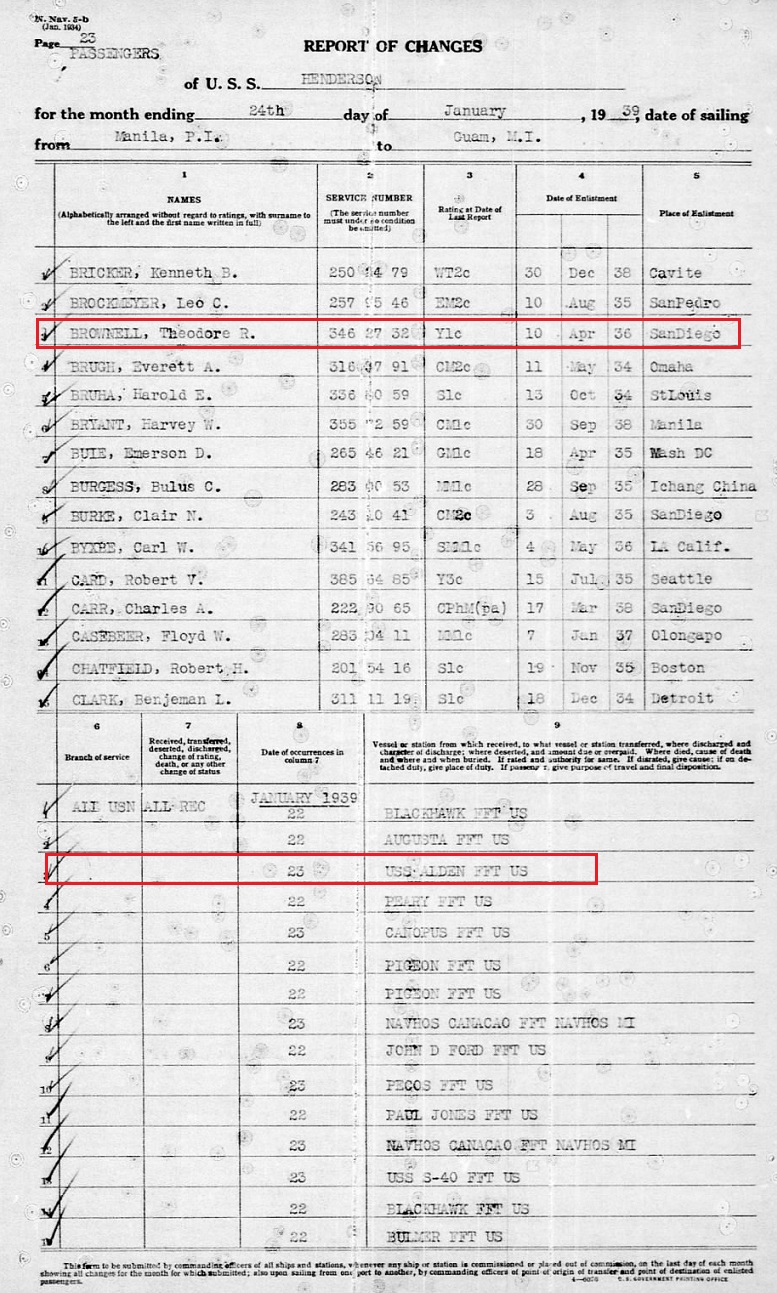
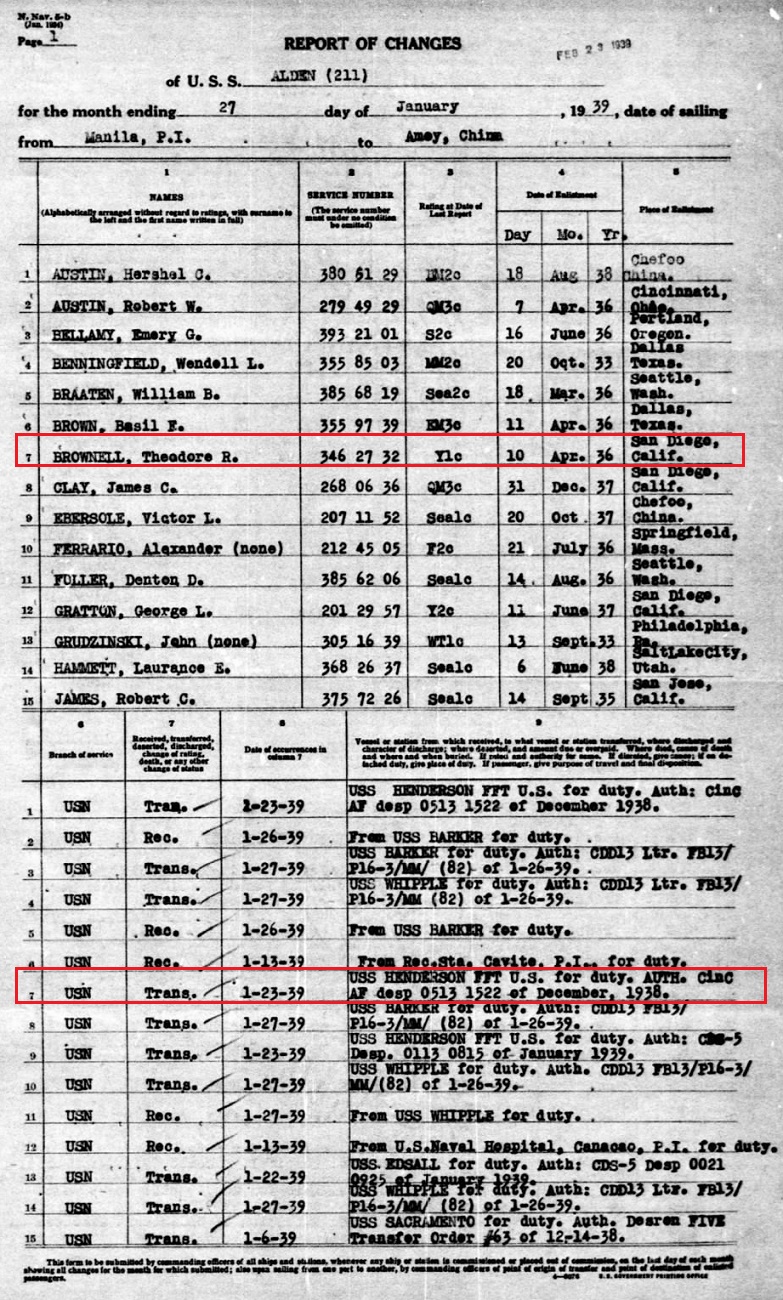
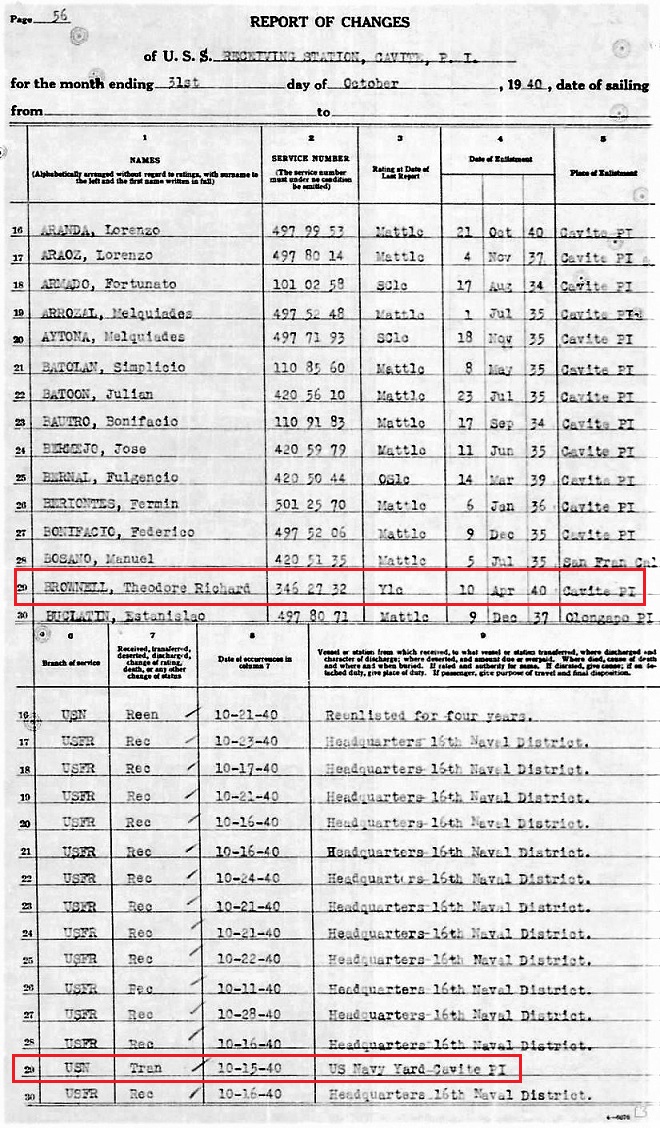
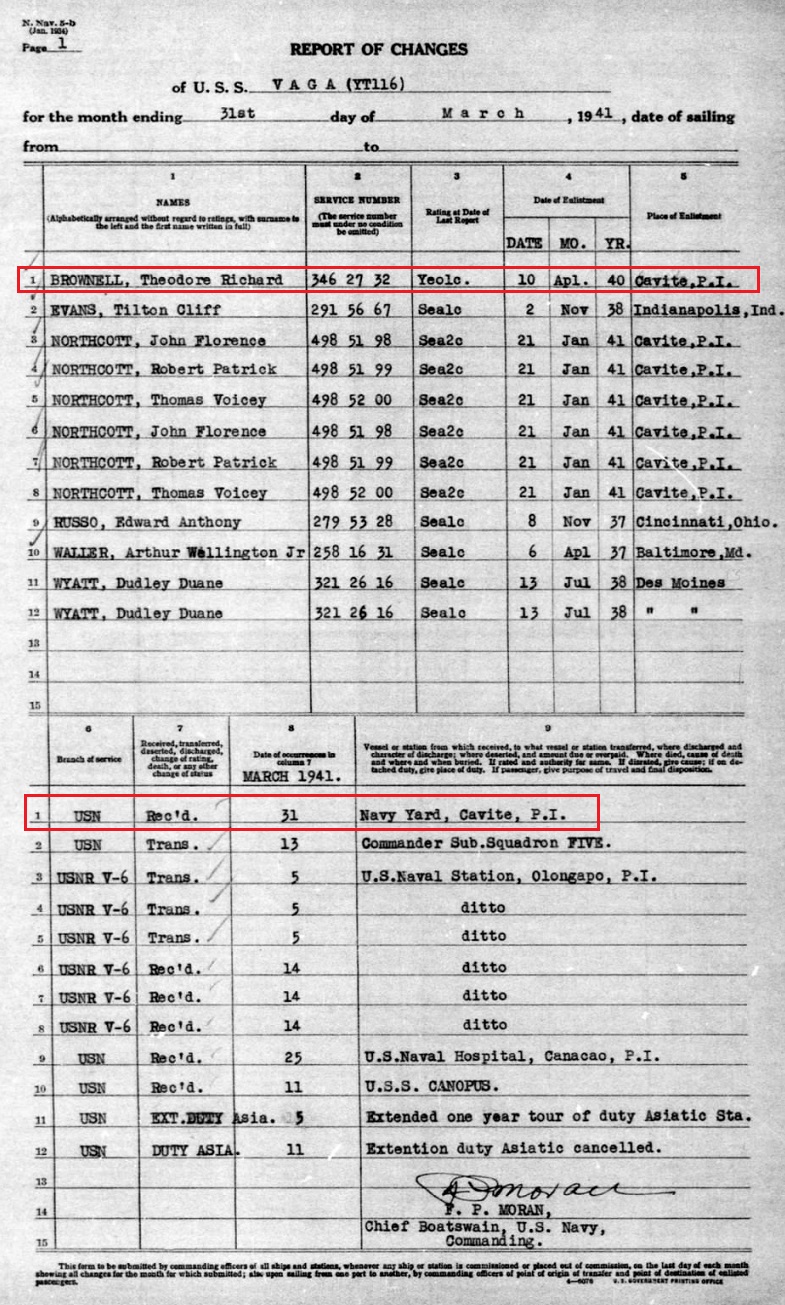
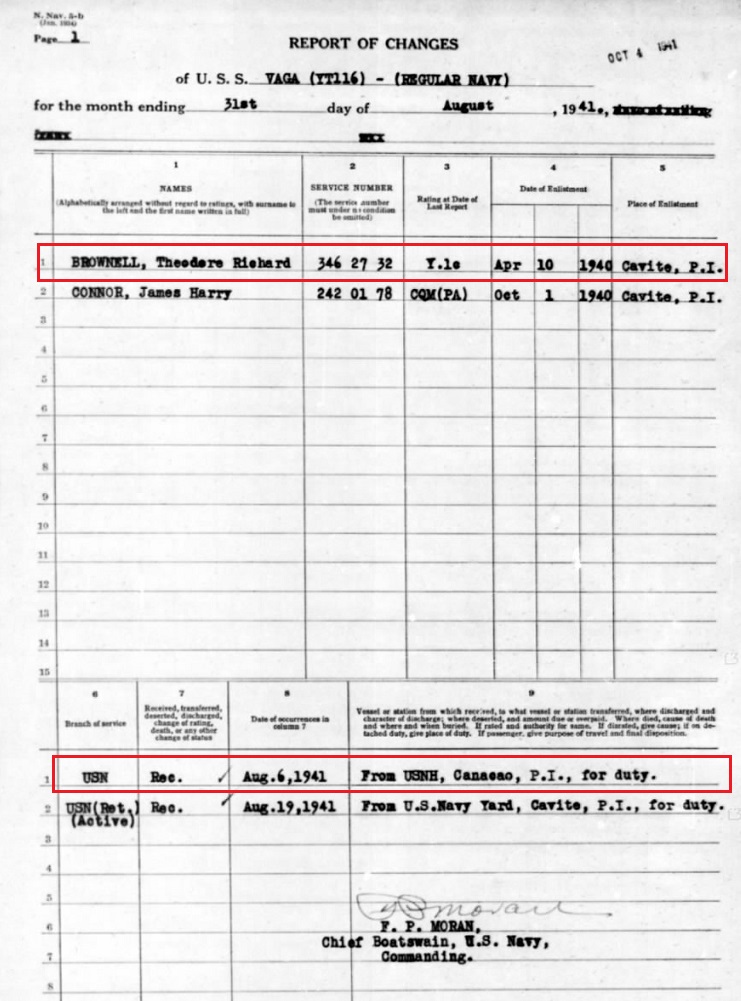
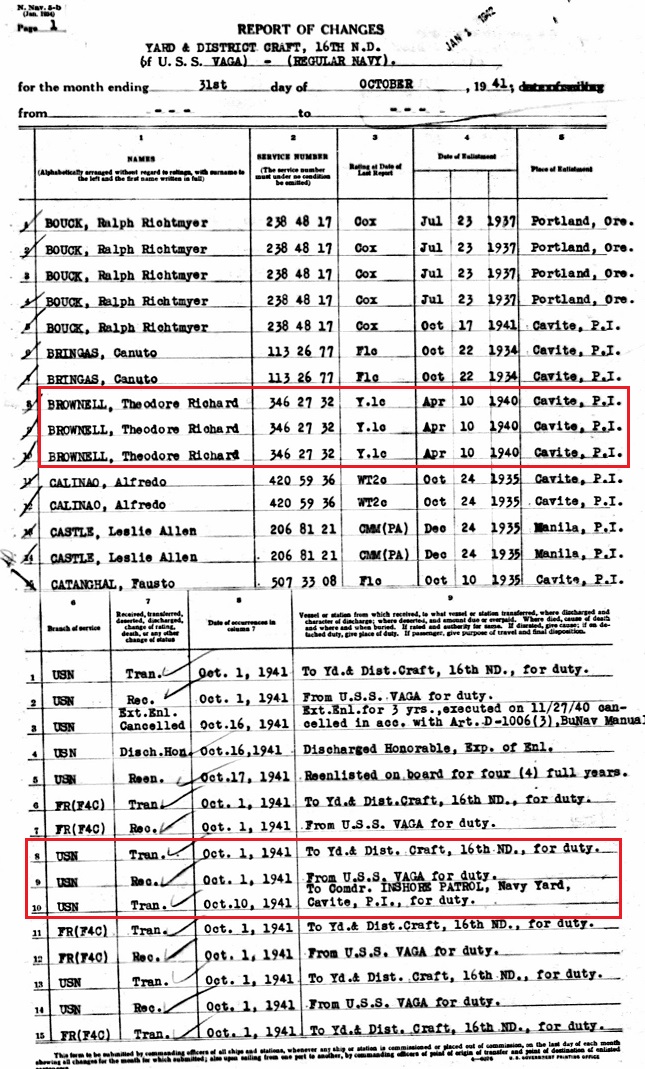
|
|
| |